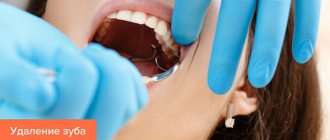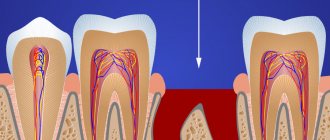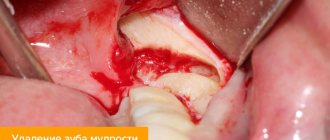26.11.2019
Removing a tooth that has become sore is a difficult process that requires surgery, as well as careful attention to oral care. Let's look at what happens to the gums when a tooth is removed, in which cases sutures are necessary, and what preventative measures are taken.
What happens to the gum after removal?
The intervention associated with the operation requires sutures. After all, it is often impossible to remove a tooth that sits deep in the gum without surgical manipulation. The gums react quite sensitively to such things, they can become inflamed and almost always bleed.
If a wisdom tooth is to be removed, it is often necessary to cut a section of the gum and then apply stitches to quickly heal the wound. The gum is a mucous membrane, it covers the processes next to the lower and upper jaws, and is located directly next to the teeth.
After the dentist removes or simply pulls out a tooth, the gums become more sensitive and easily vulnerable to various microbes. For many people with periodontal disease, the gums are generally very irritated, and the slightest intervention leads to severe bleeding, purulent discharge and an unpleasant burning sensation.
Indications for suturing
It is necessary to sew up the hole after tooth extraction if extraction is performed:
- dystopic and impacted dental units with a destroyed crown and severely curved roots,
- wisdom teeth
Another indication for wound suturing is to prevent severe bleeding. The doctor may decide to use stitches if:
- the patient is diagnosed with gingivitis or periodontitis,
- there is a suspicion of a blood clotting disorder.
When to apply sutures after tooth extraction
Sutures are applied in several cases:
- If the gums begin to bleed heavily, the bleeding does not stop, purulent inflammation or severe pain in the tissue area appears.
- If wisdom teeth or distant teeth that require surgical intervention are removed. Sometimes the process is complicated by the fact that the tooth is subject to severe decay and there is a risk of infection.
It is important to understand that this procedure requires constant monitoring by a specialist. Often people neglect weekly examinations, which leads to complications. But a competent doctor will never prescribe an operation without checking the pictures.
Today, even a wisdom tooth is removed if indicated; it was previously believed that its appearance in itself was a negative factor. A wisdom tooth is removed in the following cases:
- If it interferes with other teeth. When a tooth begins to grow incorrectly, it pushes its neighbors apart, which can lead to complications.
- If a tooth rots, caries has formed on it.
- If a tooth bleeds, it comes out slowly and causes severe discomfort to the person.
- If a tooth grows into the gum, it injures it, which leads to constant bleeding.
Sutures after wisdom tooth removal
If there are indications for removal, then they will medically indicate to you the need for “extraction of third molars” - a complex type of operation performed by dental surgeons. In order to remove the “tooth eight” you need to cut the fabric, and you cannot do without seams.
Sutures promote rapid tissue healing, help cope with the loss of blood clots, and avoid infection. When you visit a free clinic, you will receive regular stitches, which will be removed after a week. But during treatment in a modern clinic, they will offer to sew up the hole with self-absorbing material.
They are divided into two types:
- Simple synthetic. It is made from a substance that dissolves in the mouth after about a month. Does not cause inflammation, promotes rapid wound healing, and protects against infection.
- Catgut. This remedy dissolves in two weeks, the breakdown occurs without any harm to the body.
There are problematic and advanced cases that require additional medical intervention. If, after suturing, blue swelling appears near the wound, and then it turns brown, and a little later a white film forms, then the sutures will have to be removed - pus has appeared.
The wound was infected, which means it needs to be treated with a special solution and then stitched again. Inflammation is a fairly rare phenomenon. It occurs if hygiene measures are not followed.
Therefore, carefully monitor how the treatment is progressing. Do not put your hands in your mouth, do not pick or scratch the suture site, wash food thoroughly before eating, and pay attention to the heat treatment of foods. It is undesirable to drink alcohol or eat too fatty or rough foods during the period of suturing. It is also undesirable to touch the wound with your tongue or touch it in general.
If all procedures go without complications, the stitches will be removed in a week, the wound will resolve, and you will forget about the unpleasant period after the operation.
Sutures to prevent bleeding
As we have already written, all people have different perceptions of surgical intervention. When a tooth is removed, the gums often bleed, but in a normal situation the bleeding goes away quickly. If a person has indications for suturing, this means that the specialist recommends avoiding complications. For people with bleeding gums and periodontal disease, complications can be quite significant.
For example, if damaged, some dirt may get into the wound, which will lead to suppuration, which means that the treatment will not take a week, but a month or more. Usually, after a tooth is removed, the wound is thoroughly washed, a special drug is injected that will numb it, and stitches are applied.
After a week, the doctor checks how the wound is healing. If blood periodically continues to bother the patient, then he is entitled to special treatment - drugs are prescribed, a special ointment is prescribed.
It is important to understand what causes excessive bleeding after the wound is sutured. If it is brownish-brown, and a blue tint appears near the seams, turning into a white film with yellow veins, then you need to urgently visit a doctor. The sutures will have to be removed and anti-inflammatory treatment prescribed.
Usually, to prevent bleeding, the gums are sutured with simple synthetic sutures; if the patient has the opportunity to visit a modern high-quality clinic, then he can count on sutures that dissolve within two weeks. They are completely safe for the body and hypoallergenic, and most importantly, they practically do not bother the patient.
Complex tooth extraction: features of the procedure
Before performing a surgical intervention, the specialist prescribes the necessary diagnostic examination (instrumental and laboratory) to the patient. First, he is sent for an X-ray examination. Using this technique, it is possible to assess the general condition of the root system and clearly see the location of the tooth in the jaw. For a more detailed analysis, obtaining images of various dental structures layer by layer, computed tomography is prescribed. It makes it possible to detect in advance the factors complicating the surgical intervention, to establish the approximate time and complexity of the procedure.
Removal of a molar or premolar is always performed under the influence of an anesthetic. To avoid negative consequences, it is recommended to first visit an anesthesiologist to identify a possible allergic reaction to a particular substance. To determine contraindications (for example, exacerbation of a chronic disease), it is recommended to undergo laboratory diagnostics - a general blood test. In the absence of contraindications, they proceed to surgical intervention. The procedure and technique for implementing the removal technique are as follows:
- Conducting anesthesia. Depending on the age, neglect of the clinical case and the general physical condition of the patient, local or general anesthesia with a potent drug may be used.
- Incision of soft tissues and separation of gums.
- Sawing out a small area of bone tissue and the coronal part, sawing the septum (only if necessary).
- Gently rocking the tooth using special tools and removing it completely.
- Applying sutures to the gum area.
If the wisdom tooth is located next to the mandibular nerve, the procedure becomes a little more complicated. This is because its roots are able to surround the area of the nerve. In such a situation, the roots are divided and removed with extreme caution so as not to touch the nerve. To carry out high-quality surgical intervention, a qualified dental surgeon is required.
Recommendations for oral care after surgery
After applying stitches, you must follow a number of rules:
- Do not pick at the wound again, do not touch it with your hands or tongue
- Don't eat too fatty foods
- It is better to give up solid foods - apples, nuts, seeds
- Do not try to remove stitches yourself
- Rinse your mouth with Rotokan solution and other means prescribed by your doctor.
- It is recommended to brush your teeth with a new toothbrush
- It is not recommended to use dental floss near the suture site.
- Don't drink alcohol
- Do not use medications that thin the blood
- Do not drink coloring or too hot drinks - coffee, black tea, lemonade, soda
- Do not try to stop the bleeding if intense bleeding occurs using self-prescribed medications. It is better to go to a 24-hour dental clinic or call a doctor at home.
Rehabilitation period
If the doctor had to stitch up the hole after tooth extraction, the recovery period may increase. It is important to follow the recommendations of a specialist to avoid complications.
- Do not smoke, eat or rinse your mouth for several hours after surgery.
- Do not touch seams with hands or objects.
- For 3-7 days, exclude very cold and hot foods from the diet, as well as solid foods - apples, seeds, nuts, etc.
- Carry out oral hygiene only with products prescribed by your doctor.
- Avoid getting food into the seam area.
Do not attempt to remove stitches yourself, as this may cause injury and infection of the wound. Only a physician should remove non-absorbable suture material. Before the procedure, the specialist assesses the condition of the tissues.
Complex tooth extraction in Moscow: reviews of treatment at A-Medic
Olga, 41 years old. Last month I had an operation to remove a tooth at A-Medic dentistry. I made an appointment with Ziyad Ganiev without any problems. He is a true professional in his field. The procedure was successful, the doctor gave recommendations, followed them completely, and there were no complications.
Pavel, 27 years old. For several years now I have been receiving treatment only at the A-Medic clinic. Recently my wisdom teeth started to erupt and hurt a lot. The doctor advised to remove it. Removal took place quickly and without any discomfort. I recommend A-Medic dentistry to everyone.
Natalya, 32 years old. "A-Medic" is my favorite dentistry. The atmosphere in the room is pleasant, the doctors are experienced, making an appointment is not difficult. The other day I needed to remove the eight. My friends told me that this would be a difficult and painful operation. I signed up for removal with the Blazhentseva Rada. The operation took place in just a few minutes, and the recovery period took only two days.
Duration of resorption and removal of sutures
The decision to remove the threads is made based on the results of an interim examination demonstrating the rate of tissue regeneration. Practice shows that the duration of wearing stitches is no more than a week, after which the area is examined for the presence of swelling, inflammatory processes and the stage of healing. If necessary, the wearing period can be extended by 2-3 days.
If the patient is highly susceptible to pain, suture removal is performed using local anesthesia. A prerequisite is complete treatment of the cavity
Symptoms of seam dehiscence
Remember that the presence of aching pain, slight swelling and discomfort in the oral cavity is considered normal within three days from the date of surgery. Let's look at a few signs that may indicate seam separation:
- Presence of blood on the wound. It may come out abundantly or leak slightly.
- Body temperature may be several degrees higher than normal.
- The pain does not go away, but only intensifies.
- Swelling, feeling of pulsation and redness of soft tissues.
- Sometimes there is the formation of pus and an unpleasant taste in the mouth.
Types of seams. Types of threads
In each case, when the dental surgeon sutures the gum, he decides which suture to use.
Seams can be intermittent or continuous.
The first type is more common and is characterized by the overlapping of separate, unrelated stitches (pictured below), and each is secured with its own knot.
This maintains the integrity of the fabrics, even if one of the stitches fails and falls off.
There is continuous suturing. All stitches are made with a single suture thread, securing them with a common knot. It's faster, but any damage to one stitch can ruin the entire thread construction.
Absorbable and non-absorbable threads are used to suture the gums.
Sutures that dissolve
Natural (Catgut) and synthetic (Vicryl, Dexon) threads are used. When suturing the gums with Catgut, it can stay on the wound for at least 2 weeks. It is dissolved by saliva substances, but due to its protein base it often causes allergies with inflammation of the gums.
Catgut is contraindicated if there is a high risk of inflammatory complications. Dental surgeons are using this material less and less.
Synthetic Vicryl is safe in terms of tolerability, adheres tightly to the gum, and does not change its strength properties during disinfection. If the doctor does not prescribe a time limit for removing the threads, they will still dissolve within 3 months.
Dexon will last on the gums a little longer than Vicryl, otherwise their properties are similar.
No one can say for sure how long it takes for threads to dissolve in a particular patient. This depends on individual factors: characteristics of the wound, the chemical environment of the oral cavity, general immunity, and the patient’s hormonal status.
When absorbed, the thread does not disappear without a trace, but gradually disintegrates into particles, which are spat out or swallowed by the patient. It is not dangerous to health.
Threads that do not dissolve
Non-absorbable threads are nylon, silk, polyamide fiber (nylon). Synthetic threads are completely hypoallergenic.
Sutures made from non-absorbable sutures are called non-absorbable or non-absorbable sutures. Their removal after the stitches have healed is mandatory. If such threads are used and there are no complications, the surgeon will release the patient from them 7–10 days after the tooth has been pulled out or another operation on the gums has been performed.











